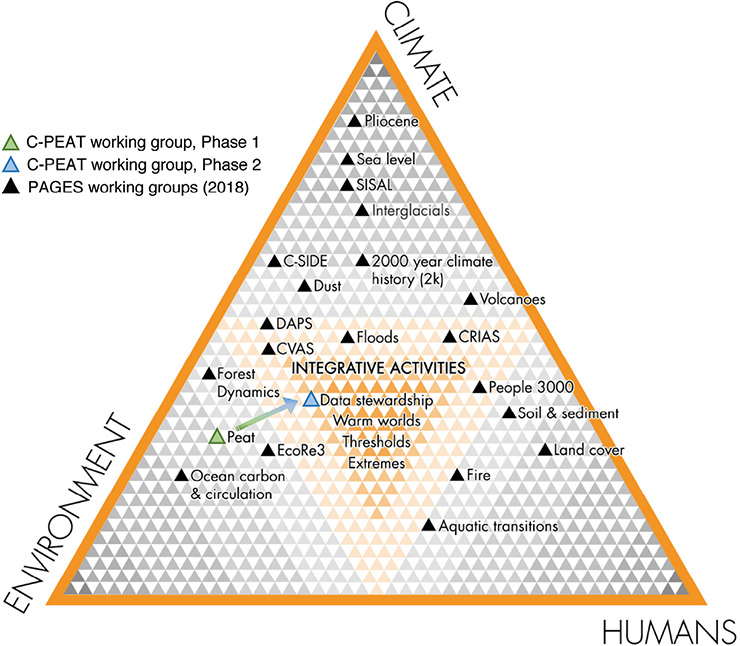- Home
- Publications
- PAGES Magazine
- New Research Directions For The PAGES C-PEAT Working Group
New research directions for the PAGES C-PEAT working group
Loisel J & Gallego-Sala A
Past Global Changes Magazine
26(2)
91
2018
Julie Loisel1 and Angela Gallego-Sala2
College Station, USA, 10-13 May 2018
Members of the C-PEAT working group met at Texas A&M University to define their research plan for Phase 2. The past three years have led to the development and publication of a large database containing over 500 peat records that have been primarily used to (1) reconstruct Holocene carbon and nitrogen sequestration rates across the northern peatland domain, and (2) connect centennial- and millennial-scale changes in carbon sequestration rates to key climatic forcings and environmental controls (Charman et al. 2012; Loisel et al. 2014; Treat et al. 2015). C-PEAT is in the process of making its entire peatland database available on WDS-PANGAEA; 164 sites are readily available under the project name PAGES_C-PEAT. Those same peat profiles have also been ingested in the International Soil Carbon Network’s database (ISCN) and are accessible on its website. These two data sharing activities took place during a “data hackathon” shortly before this workshop. An article in Earth System Science Data, describing the entire database, is in development.
Building on the success of Phase 1, there is a clear need to grow C-PEAT’s research scope. Workshop participants identified future tasks that ultimately aim to further integrate peatlands into land-surface models:
Predict peatland responses to natural and anthropogenic disturbance. Workshop participants agreed that “sensitive processes” such as (a) peatland dynamics that govern decadal-scale vertical peat accumulation and net carbon balance, and (b) margin dynamics that control horizontal peat development (expansion vs. contraction) need to be further connected to disturbance regime including fire, permafrost thaw, invasion by new species, drainage, prescribed burning, and other land-management scenarios. Here, the paleo perspective acquired during Phase I will be used to compare and contrast the importance of climatic forcings, environmental controls, and land management on peat formation and carbon sequestration. Workshop participants are preparing a manuscript that addresses these new research directions and highlights the relevance of peatland dynamics in land-surface models.
Further develop and promote the use of multi-proxy peatland records as paleoclimatic archives. The peat cores included in the C-PEAT database could be used in conjunction with those from other archives such as lake sediments, tree rings and ice cores. For example, there is an array of traditional and novel peat-based proxies for temperature and hydrology. Of particular interest to the C-PEAT group is (a) a combination of compound-specific stable isotope measurements to back-calculate changes in rainfall regimes (Amesbury et al. 2015), (b) a suite of novel organic biomarkers that are sensitive to temperature and pH or that provide insight into the carbon cycle (Naafs et al. 2017), and (c) the integration of more-traditional proxies such as plant macrofossils and testate amoebae into process-based peat models such as DigiBog (Baird et al. 2012) and the Holocene Peat Model (Frolking et al. 2010) to further understand the encoding of these proxies into the peat matrix over time. Many of these datasets are already integrated to WDS-Neotoma.
Thus far, the C-PEAT working group has been associated with “environmental research” in the PAGES science structure (Fig. 1), as peatlands are key biosphere ecosystems that interact with the climate and introduce feedbacks into the Earth system. While this remains true, Phase 2 brings peat towards the center of the triangle (Fig. 1), as this working group is integrating land-use change and natural disturbance.
acknowledgements
We thank PAGES, INQUA, and Texas A&M’s Department of Geography for financial and logistical support.
affiliations
1Department of Geography, Texas A&M University, College Station, USA
2Department of Geography, College of Life and Environmental Science, University of Exeter, UK
contact
Julie Loisel: julieloisel tamu.edu (julieloisel[at]tamu[dot]edu)
tamu.edu (julieloisel[at]tamu[dot]edu)
references
Amesbury MJ et al. (2015) Geochim Cosmochim Acta 164: 161-174
Baird AJ et al. (2012) Ecohydrology 5: 242-255
Charman DJ et al. (2012) Biogeosciences 10: 929-944
Frolking S et al. (2010) Earth Sys Dyn 1: 1-21
Naafs BDA et al. (2017) Geochim Cosmochim Acta 208: 285-301

